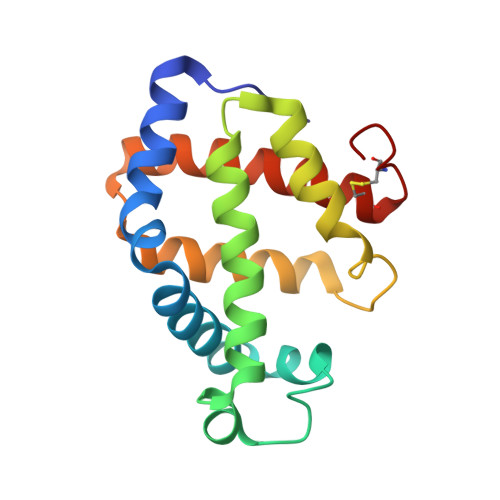pH-dependent structural changes in haemoglobin component V from the midge larva Propsilocerus akamusi (Orthocladiinae, Diptera)
Kuwada, T., Hasegawa, T., Takagi, T., Sato, I., Shishikura, F.(2010) Acta Crystallogr D Biol Crystallogr 66: 258-267
- PubMed: 20179337
- DOI: https://doi.org/10.1107/S0907444909055760
- Primary Citation of Related Structures:
2ZWJ, 3A5A, 3A5B, 3A5G, 3A9M - PubMed Abstract:
Haemoglobin component V (Hb V) from the midge larva Propsilocerus akamusi exhibits oxygen affinity despite the replacement of HisE7 and a pH-dependence of its functional properties. In order to understand the contribution of the distal residue to the ligand-binding properties and the pH-dependent structural changes in this insect Hb, the crystal structure of Hb V was determined under five different pH conditions. Structural comparisons of these Hb structures indicated that at neutral pH ArgE10 contributes to the stabilization of the haem-bound ligand molecule as a functional substitute for the nonpolar E7 residue. However, ArgE10 does not contribute to stabilization at acidic and alkaline pH because of the swinging movement of the Arg side chain under these conditions. This pH-dependent behaviour of Arg results in significant differences in the hydrogen-bond network on the distal side of the haem in the Hb V structures at different pH values. Furthermore, the change in pH results in a partial movement of the F helix, considering that coupled movements of ArgE10 and the F helix determine the haem location at each pH. These results suggested that Hb V retains its functional properties by adapting to the structural changes caused by amino-acid replacements.
- Laboratory for Electron Beam Research and Application (LEBRA), Institute of Quantum Science, Nihon University, Funabashi, Chiba 274-8501, Japan. kuwadat@lebra.nihon-u.ac.jp
Organizational Affiliation:


















